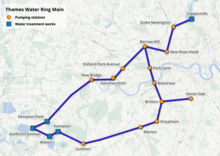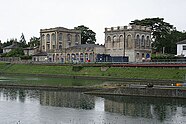
A | B | C | D | E | F | G | H | CH | I | J | K | L | M | N | O | P | Q | R | S | T | U | V | W | X | Y | Z | 0 | 1 | 2 | 3 | 4 | 5 | 6 | 7 | 8 | 9

Hampton Water Treatment Works are water treatment works located on the River Thames in Hampton, London. Built in the second half of the 19th Century to supply London with fresh water, the Waterworks was in the past a significant local employer, and its brick pumphouses dominate the local landscape.[1] The Waterworks are currently owned and operated by Thames Water, occupying a 66 ha site located between the Upper Sunbury Road (A308) and the River Thames. The Waterworks currently has a maximum output of 700 megalitres a day, and supplies ~30% of London's fresh water.[2]
History
Construction of the Waterworks began in the 1850s as a joint venture of the Grand Junction Waterworks Company, the Southwark and Vauxhall Waterworks Company, and the West Middlesex Waterworks Company, following the passage of the 1852 Metropolis Water Act,[3] which made it unlawful to take drinking water from the tidal Thames below Teddington Lock because of the amount of sewage in the tidal river. The original works were designed by Joseph Quick and J.W. Restler, and initially comprised sand filter beds to remove suspended solids from the river water, and three massive engine pump houses constructed in Gault brick, with large arched windows and decorative balustrades.[1]

The site was expanded in the 1860s with additional filtration, water storage and steam driven pumping plant built. The last engine house on the site was completed in 1900, and with the establishment of filter beds between Belgrade Road and Rose Hill in the early 20th century (drained in the 1990s to become Hampton Green), the Waterworks came to dominate the southern and western sides of Hampton. The various water companies were amalgamated into the Metropolitan Water Board in 1902.[1]
Once complete the Waterworks were among the largest in the world at the time, supplying over 400 megalitres a day and requiring over 100 tons of coal for the pumphouses. Coal was supplied on barges unloaded at Hampton wharf and moved by cart to the Waterworks. Difficulties with this arrangement led to the construction of the Metropolitan Water Board Light Railway in 1915. The Railway connected the wharf to the Waterworks and Kempton Park pumping station. The Railway also continued to a standard gauge railway siding at Sunbury station, which allowed for coal to be delivered via the London and South Western Shepperton branch line when the river was in flood or operators were on strike.[4][5]
Operations

In addition to water abstracted locally from the Thames the Waterworks also receives water from other sources. Water is supplied via the Staines Reservoirs Aqueduct (built 1902) from the King George VI Reservoir (1947) and Staines Reservoirs (1902) which receive their water from the River Thames at Hythe End, just above Bell Weir Lock. The aqueduct passes, and transports water from, the Queen Mary Reservoir (1924) and the Water Treatment Works at Kempton Park, which used to be connected to Hampton via the Metropolitan Water Board Railway. Water was also supplied from the Knight and Bessborough Reservoirs (1907) and the Queen Elizabeth II Reservoir (1962) on the opposite (south) side of the Thames. The Hampton works is also the starting point of the Thames-Lea tunnel (1960) which transfers water to the reservoirs in the Lea Valley.
The Waterworks conducts a test of its warning siren (to be used in the event of an unauthorised or accidental release of chlorine or other hazardous material) every Tuesday at approximately 9 a.m. The siren is a former air raid siren dating from the Second World War, and is audible throughout Hampton and Molesey.[6]
See also
References
- ^ a b c "HAMPTON VILLAGE DRAFT CONSERVATION AREA APPRAISAL CONSERVATION AREA NO.12". London Borough of Richmond upon Thames. Retrieved 17 November 2023.
- ^ "King of the castle Hampton completes sand bed upgrade". Thames Water. 19 February 2021. Retrieved 17 November 2023.
- ^ An Act to make better Provision respecting the Supply of Water to the Metropolis, (15 & 16 Vict. C.84)
- ^ "History of the Railway". Hampton Kempton Waterworks Railway. Retrieved 17 November 2023.
- ^ Sheaf, John; Howe, Ken (1995). Hampton and Teddington Past. London: Historical Publications. pp. 80–81.
- ^ Rawes, I.M. "The Sirens of Hampton". London Sound Survey. Retrieved 5 March 2023.
Further reading
- Hampton Waterworks, One Hampton
Text je dostupný za podmienok Creative Commons Attribution/Share-Alike License 3.0 Unported; prípadne za ďalších podmienok. Podrobnejšie informácie nájdete na stránke Podmienky použitia.
Antropológia
Aplikované vedy
Bibliometria
Dejiny vedy
Encyklopédie
Filozofia vedy
Forenzné vedy
Humanitné vedy
Knižničná veda
Kryogenika
Kryptológia
Kulturológia
Literárna veda
Medzidisciplinárne oblasti
Metódy kvantitatívnej analýzy
Metavedy
Metodika
Text je dostupný za podmienok Creative
Commons Attribution/Share-Alike License 3.0 Unported; prípadne za ďalších
podmienok.
Podrobnejšie informácie nájdete na stránke Podmienky
použitia.
www.astronomia.sk | www.biologia.sk | www.botanika.sk | www.dejiny.sk | www.economy.sk | www.elektrotechnika.sk | www.estetika.sk | www.farmakologia.sk | www.filozofia.sk | Fyzika | www.futurologia.sk | www.genetika.sk | www.chemia.sk | www.lingvistika.sk | www.politologia.sk | www.psychologia.sk | www.sexuologia.sk | www.sociologia.sk | www.veda.sk I www.zoologia.sk










